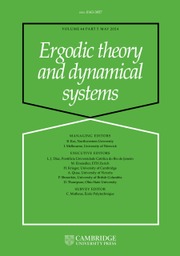Article contents
The Cuntz semigroup and the radius of comparison of the crossed product by a finite group
Published online by Cambridge University Press: 10 March 2021
Abstract
Let G be a finite group, let A be an infinite-dimensional stably finite simple unital C*-algebra, and let  $\alpha \colon G \to {\operatorname {Aut}} (A)$ be an action of G on A which has the weak tracial Rokhlin property. Let
$\alpha \colon G \to {\operatorname {Aut}} (A)$ be an action of G on A which has the weak tracial Rokhlin property. Let  $A^{\alpha }$ be the fixed point algebra. Then the radius of comparison satisfies
$A^{\alpha }$ be the fixed point algebra. Then the radius of comparison satisfies  ${\operatorname {rc}} (A^{\alpha }) \leq {\operatorname {rc}} (A)$ and
${\operatorname {rc}} (A^{\alpha }) \leq {\operatorname {rc}} (A)$ and  ${\operatorname {rc}} ( C^* (G, A, \alpha ) ) \leq ({1}/{{{\operatorname{card}}} (G))} \cdot {\operatorname {rc}} (A)$. The inclusion of
${\operatorname {rc}} ( C^* (G, A, \alpha ) ) \leq ({1}/{{{\operatorname{card}}} (G))} \cdot {\operatorname {rc}} (A)$. The inclusion of  $A^{\alpha }$ in A induces an isomorphism from the purely positive part of the Cuntz semigroup
$A^{\alpha }$ in A induces an isomorphism from the purely positive part of the Cuntz semigroup  ${\operatorname {Cu}} (A^{\alpha })$ to the fixed points of the purely positive part of
${\operatorname {Cu}} (A^{\alpha })$ to the fixed points of the purely positive part of  ${\operatorname {Cu}} (A)$, and the purely positive part of
${\operatorname {Cu}} (A)$, and the purely positive part of  ${\operatorname {Cu}} ( C^* (G, A, \alpha ) )$ is isomorphic to this semigroup. We construct an example in which
${\operatorname {Cu}} ( C^* (G, A, \alpha ) )$ is isomorphic to this semigroup. We construct an example in which  $G \,{=}\, {\mathbb {Z}} / 2 {\mathbb {Z}}$, A is a simple unital AH algebra,
$G \,{=}\, {\mathbb {Z}} / 2 {\mathbb {Z}}$, A is a simple unital AH algebra,  $\alpha $ has the Rokhlin property,
$\alpha $ has the Rokhlin property,  ${\operatorname {rc}} (A)> 0$,
${\operatorname {rc}} (A)> 0$,  ${\operatorname {rc}} (A^{\alpha }) = {\operatorname {rc}} (A)$, and
${\operatorname {rc}} (A^{\alpha }) = {\operatorname {rc}} (A)$, and  ${\operatorname {rc}} ({C^* (G, A, \alpha)} ) = ({1}/{2}) {\operatorname {rc}} (A)$.
${\operatorname {rc}} ({C^* (G, A, \alpha)} ) = ({1}/{2}) {\operatorname {rc}} (A)$.
MSC classification
Information
- Type
- Original Article
- Information
- Copyright
- © The Author(s), 2021. Published by Cambridge University Press
References
REFERENCES
- 5
- Cited by


